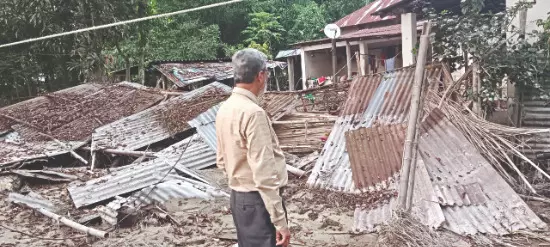Jalpaiguri floods submerge about 13,000 hectares of farmland

Jalpaiguri: On October 5, floods submerged approximately 13,000 hectares of paddy and other crops in Jalpaiguri district. As waters receded, large areas of farmland were found covered with silt, mud, sand and dolomite, according to a survey conducted by the Soil Division of the Agriculture department. The department has now begun efforts to clear these deposits and restore cultivable land.
To oversee post-flood recovery, four senior engineers have been assigned to Jalpaiguri, Alipurduar, Cooch Behar and Siliguri. The Irrigation department reported extensive damage to riverbeds, embankments, spurs, guide bunds and riverbanks, with temporary measures in place while a detailed project report (DPR) for permanent restoration is prepared. During her visit to Bamandanga Tendu in Nagrakata, Chief Minister Mamata Banerjee directed officials to remove the dolomite layers from agricultural fields to make the land cultivable again. The worst-affected blocks in Jalpaiguri district were Nagrakata and Dhupguri, followed by Moynaguri, Jalpaiguri Sadar and parts of Rajganj. The Agriculture department has prioritised the swift removal of mud, sand and dolomite layers, alongside efforts to spray pesticides and provide essential micronutrients and medicines to affected fields. On-site training sessions are also being conducted to guide farmers on adapted agricultural practices under post-flood conditions.
Rivers in the region remain volatile. In Alipurduar, the Torsa and Sishamara rivers damaged embankments and guide bunds. In Jalpaiguri’s Maynaguri area, the Jaldhaka River’s right embankment suffered breaches at five points, forming large craters. Restoration efforts are underway to repair embankments and restore river flow. Severe damage has also been reported to the Gilaidanga embankment in Mathabhanga, while the Diana, Gatia and Kuchi Diana rivers in Nagrakata destroyed roads, bridges, houses and embankments.
Krishnendu Bhowmik, Chief Engineer of the North Division overseeing Jalpaiguri district, said: “We have conducted extensive ground inspections across the district. In coordination with senior officials from the state Irrigation department, the district irrigation team and the District Magistrate, we aim to bring the situation under temporary control within a month, provided there is no further heavy rainfall. Temporary diversions have already been implemented and the four senior engineers are operating directly from their respective district offices.”



